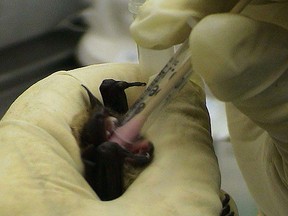
A Brantford-Brant resident who was hospitalized after acquiring rabies has died.
Advertisement 2
Article content
On Sept. 6, the Brant County Health Unit (BCHU) reported a local person was in hospital after contracting the virus from a suspected exposure to a bat in the Gowganda area, between Sudbury and Timmins in northern Ontario.
At a Haldimand-Norfolk board of health meeting on Wednesday, Dr. Malcolm Lock, medical officer of health for the Haldimand-Norfolk Health Unit (HNHU), which is in talks to merge with BCHU, said the case involved a child, who “ unfortunately… is now deceased.”
The child died roughly two weeks ago after being hospitalized in Hamilton, Lock told The Spectator after the meeting.
It was the first case of human rabies in Ontario since 1967.
The viral infection is typically transmitted through a bite or scratch from an infected animal, such as a bat, skunk, fox or raccoon — the most common animals to carry rabies in Canada, a media release from BCHU said at the time.
Advertisement 3
Article content
While it’s extremely rare — only 26 human cases have occurred in Canada since 1924 — it is serious, causing brain and spinal cord inflammation.
Once symptoms — like fever, headache or weakness — start to show, the infection is almost always fatal, although there are more than a dozen cases in which a procedure called the “Milwaukee protocol” was used and the patients survived.
Prophylactic treatment — washing the wound, receiving antibodies and getting a four-dose vaccine — is extremely effective in preventing rabies from developing.
The child “woke up with a bat in a room, the parents looked at the child, didn’t see any signs of a bite or scratches or saliva and didn’t seek getting the rabies vaccine,” Lock said at the board of health meeting.
Advertisement 4
Article content
The BCHU would not confirm these details.
In a statement, the health unit said: “As a health information custodian, we are responsible for protecting individuals’ privacy while balancing the need to inform the public. We believe it was our duty to alert the public about this virus’ presence and its associated risks, which we have done in this instance … Our position remains that any future updates on the individual’s health are considered private, and it is not our place to share that information.”
Public health authorities and the province have released little information about the patient. Despite repeated requests from The Spectator in recent weeks, the BCHU would not confirm the death, nor would the Timiskaming Health Unit, Public Health Ontario or the Public Health Agency of Canada.
Advertisement 5
Article content
Rabies still an issue
In a separate incident late last month, the BCHU reported a rabid bat found in Brantford may have bitten a person.
It’s the first time this year someone has been exposed to a rabid animal in Brantford-Brant, the Sept. 25 release said.
The person who was exposed was receiving treatment and wasn’t showing any rabies-related symptoms, the health unit added at the time.
This year, bats in the Haldimand-Norfolk area are testing at a 16 per cent positivity rate for rabies, as opposed to around 10 per cent in previous years, Lock said.
The recent case highlights that rabies is still an issue, and the importance that people with “any form of exposure seek the proper medical attention,” Lock said.
-With files from JP Antonacci
Celeste Percy-Beauregard is a Local Journalism Initiative Reporter based at the Hamilton Spectator. The initiative is funded by the Government of Canada.
Article content